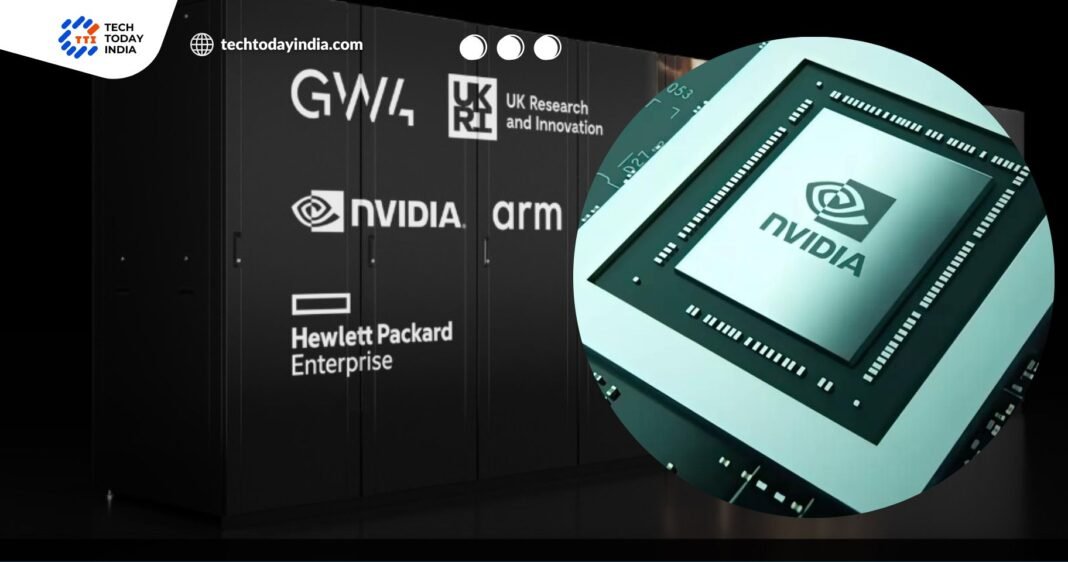NVIDIA creating Isambard 3 making a supercomputer powered by Nvidia’s unique Grace CPU Chip. In collaboration with the University of Bristol in the United Kingdom, Nvidia, a major maker of graphics processing units (GPUs), has made a huge jump into the central processing unit (CPU) industry. The collaboration seeks to create Isambard 3, a revolutionary supercomputer powered by Nvidia’s unique Grace CPU chip. This article digs into the specifics of this relationship, detailing Nvidia’s debut in the CPU market, the Grace chip’s characteristics, and the transformative potential of Isambard 3 in scientific research.
Table of Contents
Nvidia’s Venture Into the CPU Market
Nvidia’s GPUs have become quite popular due to their capacity to expedite artificial intelligence activities. However, Intel and AMD have long dominated the CPU market. Nvidia’s foray into the CPU industry with the Grace chip demonstrates the company’s desire to expand its influence and challenge the incumbent CPU competitors. Nvidia hopes to create high-performance computing solutions that push the boundaries of scientific research by combining its GPU expertise with the new Grace CPU.
The Grace CPU: A Game-Changing Chip
Nvidia’s Grace CPU processor is based on the Arm architecture. It makes use of technology developed by SoftBank Group Corp.-owned Arm Ltd., which is known for its efficient and scalable design. Grace is intended to provide breakthrough energy efficiency, allowing scientists to address complicated problems while optimizing power use. Nvidia’s Grace CPU intends to reinvent supercomputing capabilities by providing increased processing capacity and paving the road for significant scientific discoveries.
Isambard 3: An Unparalleled Performance Supercomputer
Nvidia’s work with the University resulted in the development of Isambard 3, a supercomputer that solely uses Nvidia’s Grace CPU chips. Isambard 3, developed in collaboration with Hewlett Packard Enterprise (HPE), is designed to revolutionize scientific research across multiple areas. The supercomputer will be used by the University for climate science, drug discovery, and other cutting-edge scientific initiatives.

Unleashing Isambard 3’s Power
Isambard 3 stands out for its remarkable energy efficiency. The supercomputer exceeds its predecessor, Isambard 2, by providing six times greater performance while consuming only 270 kilowatts of power. This astounding result offers up new avenues for academics, allowing them to use Isambard 3’s computing skills to tackle hard and data-intensive scientific challenges.
Isambard 3 will be utilized for medical and scientific research, as it contains 384 Arm-based NVIDIA Grace CPU Superchips. According to Nvidia, this supercomputer is six times faster and uses six times less energy than its predecessor, Isambard 2. The system is set to go into production in the Spring of 2024.
Empowering Scientific Research with Isambard 3
Nvidia’s engagement with Bristol University demonstrates its dedication to furthering scientific research. The enhanced computational capabilities of Isambard 3 will enable advancements in climate science, drug discovery, and other scientific disciplines. Nvidia and the Bristol University hope to address humanity’s most critical concerns and accelerate scientific discovery to new heights by offering researchers a cutting-edge platform.
Specific examples of how Isambard 3 could be used to advance scientific research
Climate science: Isambard 3 could be used to mimic the Earth’s climate system and predict how climate change would affect it. This data could be used to create policies and strategies to combat climate change.
Drug discovery: Isambard 3 could be used in drug discovery to screen possible new medications and identify those that are most likely to be effective. This could hasten the drug discovery process and lead to the creation of new illness treatments.
Materials science: Isambard 3 could be used to mimic material behavior and discover new materials with suitable features. This could result in the creation of new technologies such as more efficient batteries or stronger building materials.
Conclusion
Nvidia’s entry into the CPU industry offers a substantial challenge to Intel and AMD, but it also represents an important opportunity for the firm to increase its reach and influence. Nvidia is well-positioned to offer high-performance computing systems that push the boundaries of scientific research by combining its GPU expertise with the new Grace CPU.
Nvidia and the University of Bristol’s collaboration is a brilliant illustration of how public-private collaborations may accelerate innovation. These two organizations have collaborated to produce a powerful tool that will aid academics in making new discoveries and solving some of the world’s most critical challenges.
Disclaimer:
AI was used to conduct research and help write parts of the article. We primarily use the Gemini model developed by Google AI. While AI-assisted in creating this content, it was reviewed and edited by a human editor to ensure accuracy, clarity, and adherence to Google's webmaster guidelines.





